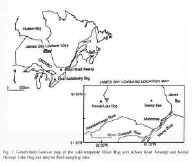International Journal of Coal Geology, 41(1999), 213-238
A COMPARISON OF TEMPERATE AND BOREAL PEATS FROM ONTARIO, CANADA: POSSIBLE
MODERN ANALOGUES FOR PERMIAN COALS
M.I. HAWKE1, I.P. MARTINI1 and L.D. STASIUK2
1Department of Land Resource Science, University of Guelph, Guelph, ON,
Canada, NlG 2Wl
2Geological Survey of Canada, 3303-33rd St. N. W., Calgary, AB, Canada
¡¡
 Peat profiles were sampled from a raised bog and an interior fen located in
the boreal James Bay Lowlands, Northern Ontario, and a cold-temperate swamp and
a cold-temperate bog in the Great Lakes-St. Lawrence Lowlands, southern Ontario.
An examination of the micromorphology and maceral compositions of the peats indicates that considerable differences exist between environments. The boreal
bog and fen both consist predominantly of relatively unaltered textinite
(commonly Sphagnum-derived), with higher liptinite contents in the fen
profile attributable to the more diverse vegetation. Both the cold-temperate
swamp and bog show high levels of humification at the surface, possibly
partially attributable to recent climatic warming trends causing a decline in
water table elevation. In all profiles, funginite was persistent, ranging from 2
to 10% of the total maceral content, indicating that aerobic conditions
generally prevailed at the surface at the time of deposition. The influence of
depositional environment and vegetation type on the resulting peat was born out
in plots of Tissue Preservation Index vs. Gelification Index. The petrographic
study also demonstrated that none of the profiles contained high inertodetrinite
/ semifusinite contents comparable to those within cold-climate cratonic Permian
Gondwana coals. Since the oxidation processes leading to the formation of
inertinite are considered to take place at the peat stage, if the peats studied
were to contain a similar maceral assemblage upon coalification, inertinite
precursors may be present in the peat. The lack of petrographic similarity
between the Holocene peats and the Permian coals may be related to a number of
factors. The decrease in water table elevation possibly responsible for the
inertinization of the Permian coals may have occurred following the cessation of
peat formation, not concurrently with accumulation, and is potentially
attributable to long-term factors such as climatic warming. The change in the
peat-forming vegetation (from Permian Glossopteris- and Gangamopteris-dominated
communities to Holocene Sphagnum and coniferous vegetation) alters the
characteristics of the initial botanical starting materials, and some aspects of
the ecology, particularly trophic and pH conditions, which control the
post-depositional alteration of the plant materials and the resulting maceral
assemblages.
Peat profiles were sampled from a raised bog and an interior fen located in
the boreal James Bay Lowlands, Northern Ontario, and a cold-temperate swamp and
a cold-temperate bog in the Great Lakes-St. Lawrence Lowlands, southern Ontario.
An examination of the micromorphology and maceral compositions of the peats indicates that considerable differences exist between environments. The boreal
bog and fen both consist predominantly of relatively unaltered textinite
(commonly Sphagnum-derived), with higher liptinite contents in the fen
profile attributable to the more diverse vegetation. Both the cold-temperate
swamp and bog show high levels of humification at the surface, possibly
partially attributable to recent climatic warming trends causing a decline in
water table elevation. In all profiles, funginite was persistent, ranging from 2
to 10% of the total maceral content, indicating that aerobic conditions
generally prevailed at the surface at the time of deposition. The influence of
depositional environment and vegetation type on the resulting peat was born out
in plots of Tissue Preservation Index vs. Gelification Index. The petrographic
study also demonstrated that none of the profiles contained high inertodetrinite
/ semifusinite contents comparable to those within cold-climate cratonic Permian
Gondwana coals. Since the oxidation processes leading to the formation of
inertinite are considered to take place at the peat stage, if the peats studied
were to contain a similar maceral assemblage upon coalification, inertinite
precursors may be present in the peat. The lack of petrographic similarity
between the Holocene peats and the Permian coals may be related to a number of
factors. The decrease in water table elevation possibly responsible for the
inertinization of the Permian coals may have occurred following the cessation of
peat formation, not concurrently with accumulation, and is potentially
attributable to long-term factors such as climatic warming. The change in the
peat-forming vegetation (from Permian Glossopteris- and Gangamopteris-dominated
communities to Holocene Sphagnum and coniferous vegetation) alters the
characteristics of the initial botanical starting materials, and some aspects of
the ecology, particularly trophic and pH conditions, which control the
post-depositional alteration of the plant materials and the resulting maceral
assemblages.